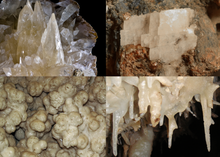
Back Kalsiet Afrikaans Calcita AN كالسيت Arabic Kalsit Azerbaijani Кальцыт Byelorussian Кальцыт BE-X-OLD Калцит Bulgarian ক্যালসাইট Bengali/Bangla Kalcit BS Calcita Catalan
| Calcite | |
|---|---|
 Clockwise from top left: scalenohedral, rhomboedral, stalactitic, and botryoidal calcite | |
| General | |
| Category | Carbonate mineral |
| Formula (repeating unit) | CaCO3 |
| Strunz classification | 5.AB.05 |
| Crystal system | Trigonal |
| Crystal class | Hexagonal scalenohedral (3m) H-M symbol: (3 2/m) |
| Space group | R3c |
| Unit cell | a = 4.9896(2) Å, c = 17.0610(11) Å; Z = 6 |
| Identification | |
| Color | Typically colorless or creamy white - may have shades of brownish colors |
| Crystal habit | Botryoidal, concretionary, druse, globular, granular, massive, rhombohedral, scalenohedral, stalactitic |
| Twinning | Common by four twin laws |
| Cleavage | Perfect on {1011} three directions with angle of 74° 55'[1] |
| Fracture | Conchoidal |
| Tenacity | Brittle |
| Mohs scale hardness | 3 (defining mineral) |
| Luster | Vitreous to pearly on cleavage surfaces |
| Streak | White |
| Diaphaneity | Transparent to translucent |
| Specific gravity | 2.71 |
| Optical properties | Uniaxial (−); low relief |
| Refractive index | nω = 1.640–1.660 nε = 1.486 |
| Birefringence | δ = 0.154–0.174 |
| Fusibility | Infusible (decrepitates energetically)[2] |
| Solubility | Soluble in dilute acids |
| Other characteristics | May fluoresce red, blue, yellow, and other colors under either SW and LW UV; phosphorescent |
| References | [3][4][5] |
Calcite is a carbonate mineral and the most stable polymorph of calcium carbonate (CaCO3). It is a very common mineral, particularly as a component of limestone. Calcite defines hardness 3 on the Mohs scale of mineral hardness, based on scratch hardness comparison. Large calcite crystals are used in optical equipment, and limestone composed mostly of calcite has numerous uses.
Other polymorphs of calcium carbonate are the minerals aragonite and vaterite. Aragonite will change to calcite over timescales of days or less at temperatures exceeding 300 °C,[6][7] and vaterite is even less stable.
- ^ Klein, Cornelis; Hurlbut, Cornelius S. Jr. (1993). Manual of mineralogy: (after James D. Dana) (21st ed.). New York: Wiley. p. 405. ISBN 047157452X.
- ^ Cite error: The named reference
Sinkankas1964was invoked but never defined (see the help page). - ^ Anthony, John W.; Bideaux, Richard A.; Bladh, Kenneth W.; Nichols, Monte C., eds. (2003). "Calcite" (PDF). Handbook of Mineralogy. Vol. V (Borates, Carbonates, Sulfates). Chantilly, VA, US: Mineralogical Society of America. ISBN 978-0962209741.
- ^ Cite error: The named reference
mindatwas invoked but never defined (see the help page). - ^ Barthelmy, Dave. "Calcite Mineral Data". webmineral.com. Retrieved 6 May 2018.
- ^ Yoshioka S.; Kitano Y. (1985). "Transformation of aragonite to calcite through heating". Geochemical Journal. 19 (4): 24–249. Bibcode:1985GeocJ..19..245Y. doi:10.2343/geochemj.19.245.
- ^ Staudigel P. T.; Swart P. K. (2016). "Isotopic behavior during the aragonite-calcite transition: Implications for sample preparation and proxy interpretation". Chemical Geology. 442: 130–138. Bibcode:2016ChGeo.442..130S. doi:10.1016/j.chemgeo.2016.09.013.